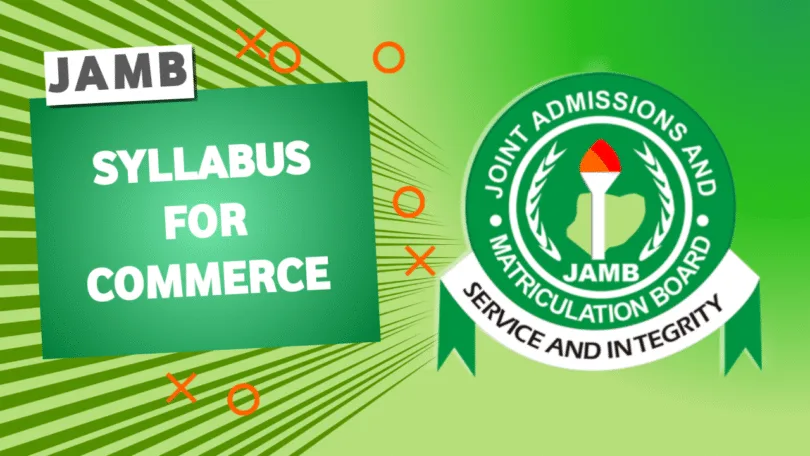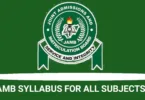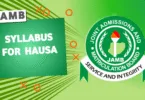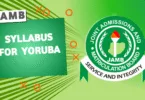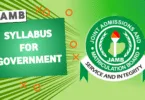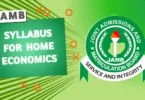If you are preparing for the JAMB UTME 2026/2027 and you want to write Commerce, then you need to make the official JAMB Syllabus for Commerce 2026 your study guide. This syllabus contains all the topics you are expected to cover before sitting for the exam.
In this article, you will see the latest JAMB Commerce syllabus, learn why it is important, and also get access to a free downloadable PDF that you can use offline.
JAMB Commerce Syllabus Overview
| Title | Detail |
|---|---|
| Exam Type | UTME |
| Exam Session | 2026/2027 |
| Syllabus Subject | Commerce |
| File Format | |
| File Size | 225KB |
Why Use the JAMB Syllabus for Commerce?
The JAMB syllabus is like a map that directs you on what to read. Instead of going through bulky textbooks without focus, the syllabus helps you know the exact topics that JAMB will set questions from. This saves you time and makes your preparation more effective.
Using the JAMB Commerce syllabus will:
- Keep you focused on the right topics.
- Prevent you from wasting time on irrelevant areas.
- Help you practice with past questions based on the right subjects.
- Increase your chances of scoring higher in the Commerce section of JAMB UTME 2026.
Topics Covered in the JAMB Syllabus for Commerce 2026
The syllabus covers everything JAMB expects you to know in Commerce. While the full detailed content is available in the PDF file, the major areas include:
- Introduction to Commerce
- Trade
- Aids to Trade (Banking, Insurance, Transportation, Warehousing, etc.)
- Business Units
- Business Capital and Financing
- Stock Exchange and Securities
- Consumer Protection and Rights
- Business Law
- Commercial Documents
- Business Management and Government Regulation
- Economic Development and Planning
- Communication in Commerce
- Current Trends in Commerce
READ ALSO: Latest JAMB Syllabus for All Subjects PDF for UTME 2026/2027
Full JAMB Syllabus for Commerce 2026/2027
| Topic / Section | Subtopics / Contents | Objectives |
|---|---|---|
| Commerce |
(i) Meaning and scope (ii) Characteristics (iii) Functions |
• Differentiate between Commerce and other related subjects • Describe the characteristics of Commerce • Identify the functions of Commerce |
| Occupation |
(i) Meaning and importance (ii) Types (industrial, commercial, services) (iii) Factors determining choice of occupation |
• State the importance of occupation • Compare types of occupation • Identify factors determining choice of occupation |
| Production |
(i) Factors, characteristics & rewards (land, labour, capital, entrepreneur) (ii) Division of labour & specialization (iii) Types (primary, secondary, tertiary) |
• Identify the factors of production & rewards • Distinguish division of labour & specialization • Classify types of production |
| Trade |
Home Trade – Retail trade (types, functions, factors, trends, advantages/disadvantages) – Wholesale trade (types, functions, merits/demerits) Foreign Trade – Basic issues (balance of trade, balance of payments, counter trade) – Procedures & documents (export, import, entrepôt trade) – Barriers, roles of Customs, Ports, etc. |
• Compare types of retailers • Identify retailer/wholesaler functions • Highlight factors in retail trade • Classify modern retail practices • Analyse foreign trade issues & procedures • Evaluate roles of government agencies |
| Purchase & Sale of Goods |
(i) Procedure & documentation (enquiry, quotation, order, invoice, pro forma invoice, statement of accounts, indent, consular invoice, bill of lading, certificate of origin, consignment note, etc.) (ii) Terms of trade (trade discount, quantity discount, cash discount, warranties, C.O.D., C.I.F., F.O.B., E.O.E.) (iii) Terms of payment: Cash (legal tender) & Credit – types, functions, merits, demerits |
• Examine procedures & documents used in purchase & sale • Determine terms of trade • Distinguish cash vs credit forms • Identify types of credit & analyse merits/demerits |
| Aids to Trade |
(a) Advertising: types, media, advantages/disadvantages (b) Banking: types, services, challenges (c) Communication: process, types, trends, barriers, merits/demerits (d) Insurance: types, principles, terms, importance (e) Tourism: importance, agencies, challenges (f) Transportation: modes, importance, advantages/disadvantages (g) Warehousing: importance, types, functions, siting factors |
• Identify advertising types & media, advantages/disadvantages • Describe bank types, services, challenges • Analyse communication process, types, trends, barriers • Explain insurance principles, terms & importance • Discuss tourism roles & challenges • Appraise transportation modes & advantages/disadvantages • Explain warehousing types, functions & siting factors |
| Business Units |
(i) Forms & features (sole proprietorship, partnership, LTD, public corporations, cooperatives, etc.) (ii) Business registration procedures (iii) Business mergers (iv) Choice determinants (v) Dissolution & liquidation (vi) Merits & demerits |
• Identify forms & features of business units • Analyse registration procedures • Examine types and reasons for mergers • Evaluate choice determinants • Distinguish dissolution & liquidation • State merits & demerits of units |
| Financing Business |
(i) Sources of finance (personal savings, sale of shares & bonds, loans, debentures, mortgage, overdraft, ploughing back profits, credit purchase, leasing, etc.) (ii) Types of capital (authorized, issued, called-up, paid-up, working capital, owners’ equity, etc.) (iii) Calculations: forms of capital, profits (gross & net), turnover (iv) Problems in sourcing finance (v) Role of bureaux de change in the economy |
• Identify various financing sources • Discuss types of capital • Compute capital forms, profits & turnover • Appraise problems of sourcing finance • Assess role of bureaux de change |
| Trade Associations |
(i) Objectives & functions of trade & manufacturers’ associations (e.g. cocoa farmers, garri sellers, poultry sellers) (ii) Objectives & functions of Chambers of Commerce |
• Discuss objectives & functions of trade associations • List objectives & functions of Chambers of Commerce |
| Money |
(i) Evolution of money (ii) Forms & qualities (iii) Functions of money |
• Discuss origin of money • Analyse forms & qualities • Appraise functions of money |
| Stock Exchange | — (listed in new JAMB topics)* | — understand stock exchange operations, functions, role in economy* |
| Elements of Business Management |
(i) Functions: planning, organizing, staffing, coordinating, motivating, communicating, controlling (ii) Principles: span of control, unity of command, delegation, etc. (iii) Organizational structures: line, staff, functional, matrix, committee (iv) Functional areas: production, marketing, finance, personnel (v) Business resources: man, money, materials, machines, goodwill/opportunities |
• Describe functions of management • Explain managerial principles • Compare organizational structures • Outline functional areas of business • Identify business resources |
| Elements of Marketing | — (recently added)* | — basics of marketing, marketing mix, strategies, role in business* |
| Legal Aspects of Business |
(i) Elements & validity of contract (ii) Agency, Sale of Goods Act, Hire Purchase Act (iii) Contract of employment (iv) Government regulations: registration, patents, trademarks, copyrights, etc. (v) Consumer protection: legislation (Standards Org, Consumer Protection Council, NAFDAC, etc.) |
• Analyse elements & validity of contracts • Explain agency, sale of goods & hire purchase provisions • Assess rights & obligations under employment contracts • Distinguish patents, trademarks & copyrights • Explore functions & roles of consumer protection agencies |
| Information & Communication Technology (ICT) | — (recent addition)* | — understand role of ICT in commerce, tools, e-commerce, digital transactions* |
| Business Environment & Social Responsibility | — (recent addition)* | — analyze external business environment, ethics, social responsibility, sustainability* |
Sources
- The official JAMB IBASS syllabus PDF includes “Commerce” as a subject in its e-syllabus portal – www.ibass.jamb.gov.ng
- Myschool.ng
How to Download the JAMB Commerce Syllabus 2026 PDF
Downloading the syllabus is very easy:
- Click on the download link provided on this page.
- Save the PDF file to your phone or laptop.
- Open it anytime to study, even without an internet connection.
With the PDF, you can organize your reading and track your progress while preparing for JAMB.
Download JAMB Commerce Syllabus 2026/2027
Kindly click on the “Download” button below to get the file saved into your phone.
Best Ways for Using the JAMB Commerce Syllabus Effectively
- Create a timetable: Break the topics into smaller parts and study consistently.
- Focus on weak areas: Spend more time on topics you don’t understand well.
- Practice past questions: Use the syllabus as a guide when answering JAMB past questions.
- Revise regularly: Go back to what you’ve studied to make sure you don’t forget.
- Stay updated: Always use the latest syllabus version to avoid missing new topics.
Conclusion
The JAMB Commerce syllabus 2026 is your best study friend if you want to pass Commerce in UTME with a high score. It gives you direction, saves time, and helps you prepare smartly. Don’t just read randomly, try and follow the syllabus, practice past questions, and stay consistent with your study schedules.
For more updates, study materials, and free downloads, always visit www.utme2026.com.
Frequently Asked Questions (FAQs) on JAMB Commerce Syllabus 2026
1. Is the JAMB Commerce syllabus compulsory?
Yes, it is. Every candidate writing Commerce in UTME must use the syllabus because it contains all the topics JAMB will set questions from.
2. Can I download the JAMB Commerce syllabus PDF for free?
Yes. The syllabus is completely free to download and can be saved to your phone or computer for offline study.
3. Does JAMB change the Commerce syllabus every year?
Not every year, but JAMB sometimes makes updates. That’s why it’s important to always use the latest syllabus.
4. How many questions come from Commerce in JAMB?
Commerce is an elective subject, and you’ll get 50 questions in the exam, covering all the topics listed in the syllabus.
5. Where can I get the official JAMB Commerce syllabus 2026?
You can get it here on this page or from reliable education websites like www.utme2026.com.
